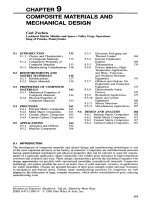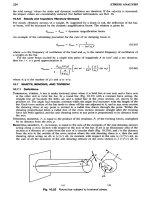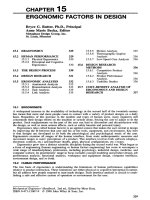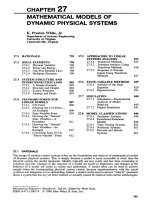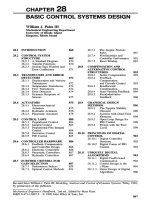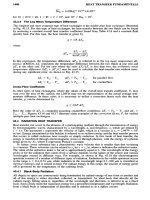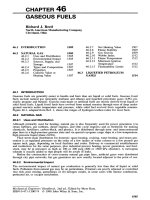Mechanical Engineer´s Handbook P18 doc
Bạn đang xem bản rút gọn của tài liệu. Xem và tải ngay bản đầy đủ của tài liệu tại đây (538.11 KB, 9 trang )
15.1 ERGONOMICS
A
widespread increase
in the
availability
of
technology
in the
second half
of the
twentieth century
has
meant that more
and
more people come
in
contact with
a
variety
of
product designs
on a
daily
basis. Regardless
of
this increase
in the
number
and
types
of
human users, many engineers still
concentrate their design
efforts
on the
machine
or
system alone, forcing
the
user
to
adjust
to fit the
product. Such readjustments
on the
part
of the
user
can
lead
to
discomfort
and
dissatisfaction with
the
design,
as
well
as
more serious
effects,
such
as
safety
hazards
and
personal
injury.
Ergonomics (also
called
human factors)
is an
applied science that makes
the
user central
to
design
by
improving
the fit
between that user
and his or her
tools, equipment,
and
environment.
Key
here
is
that designs
are
developed
to fit
both
the
physiological
and
psychological needs
of the
user.
Ergonomists examine
all
ranges
of the
human interface,
from
static
anthropometric
measures
and
movement ranges
to
users' perceptions
of a
product. This interface involves both
software
(displays,
electronic controls, etc.)
and
hardware (knobs, grips, physical configurations, etc.) issues.
Ergonomics grew into
a
distinct
scientific
discipline during
the
second world war. What began
as
a
form
of
engineering (human engineering
or
human factors engineering)
has
come
to
encompass
a
wide range
of
interdisciplinary professions, including psychology, industrial design, medicine,
and
computer
science.
Its
practitioners' range
in
focus
includes concept modeling
and
product design,
job
performance analysis,
functional
analysis, workspace
and
equipment design, computer interfaces,
environment design,
and so
forth.
15.2
HUMANPERFORMANCE
The
true basis
of
ergonomics
is
understanding
the
limitations
of
human
performance capabilities
relative
to
product interaction. These limitations
are
either physical
or
cognitive/perceptual
in
nature,
but
all
address
how
people respond
to
man-made designs. Such interface analysis
is
crucial
to
estab-
lishing
a
safe
and
effective
system
of
operation
or
environment
for the
user.
Mechanical
Engineers'
Handbook,
2nd
ed., Edited
by
Myer Kutz.
ISBN
0-471-13007-9
©
1998 John Wiley
&
Sons, Inc.
CHAPTER
15
ERGONOMIC FACTORS
IN
DESIGN
Bryce
G.
Rutter,
Ph.D.,
Principal
Anne Marie Becka, Editor
Metaphase
Design
Group,
Inc.
St.
Louis,
Missouri
15.1 ERGONOMICS
329
15.2
HUMANPERFORMANCE
329
15.2.1
Physical Ergonomics
330
15.2.2 Perceptual
and
Cognitive
Ergonomics
330
15.3
THE
DESIGN PROCESS
330
15.4
DESIGNRESEARCH
331
15.5
ERGONOMICANALYSES
332
15.5.1
Anatomical Analysis
332
15.5.2
Biomechanical Analysis
333
15.5.3
Task Analysis
335
15.5.4
Link Analysis
335
15.5.5
Motion Analysis
335
15.5.6
Thermographic
Imprint
Analysis
336
15.5.7
Low-Speed Cine Analysis
336
15.6
DESIGNRESEARCH
METHODS
336
15.6.1
Competitive Product
Analysis
336
15.6.2 Product Performance
Analysis
336
15.6.3
Usability Studies
336
15.7
COST-BENEFIT
ANALYSIS
OF
ERGONOMICS
AND
DESIGN
RESEARCH
337
Fig.
15.1
General interdisciplinary nature
of
human factors with selected
examples (from Ref.
1,
p. 90.
Reprinted
by
permission).
15.2.1
Physical
Ergonomics
A
thorough understanding
of the
physical
characteristics
of a
wide range
of
people
is
essential
to
any
product that
is
designed
for
human use. When analyzing design relative
to
human performance,
ergonomists
study static
anthropometric
data, which includes sizing percentiles (e.g., lengths, mea-
surements)
of a
wide range
of
populations, including gender, age, race,
and
other such factors. Ranges
of
joint motions, strengths,
and
grips
for
varying human
percentiles
are
also reviewed.
These
data
serve
as
valuable information
to
designers
and
help ensure
the final
product will physically
fit the
targeted end-user,
be it a
child,
the
aged,
or a
particular
racial
population,
and so
forth.
15.2.2 Perceptual
and
Cognitive Ergonomics
Proper
fit of a
product
to a
user does
not end
with
the
physical interface.
The
perceptual
and
cognitive
demands
a
product places
on a
user must also
be
examined. Note that
a
great misconception under-
lying
these capabilities
is
that they address emotive responses
of the
user. However, neither
are
qualitative
findings;
both types
offer
fact-based, quantitative data
to be
used
in
product development.
Perceptual responses
are
those
filtered
through
one or
more
of the five
senses, such
as
tactile
and
auditory
feedback
of
controls. Cognitive responses
are
based
on
logic, reason,
and how
users process
information.
Cognitive issues include intuitiveness
of
control features
and
functions
as
well
as
icon
representation
and
label comprehension.
15.3
THE
DESIGN PROCESS
Implementing
an
ergonomics program
can
help ensure
a
product's successful transition
from
the
drawing
board
to the
end-user. However, human
factors
cannot
be
examined
in a
vacuum. Ergonomists
must
work directly with designers
and
engineers throughout
the
entire design development process,
each providing feedback
to the
other during concept development
and
testing.
In
addition
to
standard
ergonomic analyses, design research should
be
conducted with targeted end-users
to
identify
design
problems that
are
often
overlooked
by the
engineer,
who
examines
the
product only within
the
design
environment.
Such end-user research serves
to
measure
a
design's overall
efficacy
on a
wide range
^Adapted
from
U.S. Army data reported
by
Gordon
et
al.
(1989)
(from
K.
Kroemer,
H.
Kroemer,
and K.
Kroemer-Elbert,
Ergonomics:
How to
Design
for
Ease
and
Efficiency,
p. 30.
©1994.
Reprinted
by
permission
of
Prentice-Hall, Englewood
Cliffs,
NJ).
b
Estimated.
Note:
In
this table,
the
entries
in the
50th percentile column
are
actually
"mean"
(average) values.
The 5th and
95th percentile values
are
from
measured data,
not
calculated (except
for
weight). Thus,
the
values given
may be
slightly
different
from
those obtained
by
subtracting
1.65
SD
from
the
mean
(50th) percentile,
or by
adding 1.65
SD to it.
of
user perception
and
knowledge levels. Resulting data
can
provide
a
tangible starting point
upon
which
design revisions
or new
product concepts
can be
made.
15.4
DESIGNRESEARCH
A
core component
of a
successful product design
is
understanding
the
wants
and
needs
of the
product's end-users. Therefore, talking with target customers
to
gain insight into their requirements
is
a
logical step
in
concept development. Unfortunately, most manufacturers
and
engineers approach
this issue through
"gut-feeling"
guesswork
—
fabricating
a
list
of
items
or
issues based
on the
premonitions
of the
development team
or
head
of
manufacturing. This method
of
design development
is
doomed
from
its
inception,
as
engineers
and
manufacturers
are
often
so far
removed
from
their
customer base that
the
resulting products never meet users' requirements
or
expectations.
Table
15.1
Body
Dimensions
of
U.S.
Civilian
Adults,
Female/Male,
in
cm
a
Heights
(f
above
floor,
j
above seat)
Stature
("height"
K
Eye
height
/
Shoulder
(acromial)
height
/
Elbow
height
7
Wrist
height
7
Crotch
height
7
Height
(sitting)
5
Eye
height
(sitting)
5
Shoulder (acromial) height
(sitting)
7
Elbow
height
(sitting)*
Thigh
height
(sitting)
5
Knee
height
(sitting)
7
Popliteal height
(sitting)
7
Depths
Forward (thumbtip) reach
Buttock-knee distance (sitting)
Buttock-popliteal distance (sitting)
Elbow-fingertip distance
Chest depth
Breadths
Forearm-forearm breadth
Hip
breadth (sitting)
Head
Dimensions
Head circumference
Head breadth
Interpupillary
breadth
Foot
Dimensions
Foot length
Foot breadth
Lateral malleolus
height
7
Hand
Dimensions
Circumference,
metacarpale
Hand
length
Hand
breadth, metacarpale
Thumb
breadth,
interphalangeal
Weight
(in kg)
Percentiles
5th
50th 95th
SD
152.78/ 164.69 162.94/ 175.58 173.73/ 186.65 6.36/6.68
141.52/ 152.82 151.61/ 163.39 162.13/ 174.29 6.25/6.57
124.09/ 134.16 133.36/ 144.25 143.20/ 154.56 5.79/6.20
92.63/ 99.52 99.79/ 107.25 107.40/ 115.28 4.48/4.81
72.79/ 77.79 79.03/ 84.65 85.51/
91.52
3.86/4.15
70.02/ 76.44 77.14/ 83.72 84.58/
91.64
4.41/4.62
79.53/ 85.45 85.20/
91.39
91.02/
97.19
3.49/3.56
68.46/ 73.50 73.87/ 79.20 79.43/ 84.80 3.32/3.42
50.91/ 54.85 55.55/ 59.78
60.36/
64.63 2.86/2.96
17.57/
18.41
22.05/ 23.06 26.44/ 27.37 2.68/2.72
14.04/
14.86
15.89/
16.82
18.02/
18.99
1.21/1.26
47.40/
51.44
51.54/ 55.88 56.02/ 60.57 2.63/2.79
35.13/
39.46 38.94/
43.41
42.94/ 47.63 2.37/2.49
67.67/ 73.92 73.46/ 80.08 79.67/ 86.70 3.64/3.92
54.21/ 56.90 58.89/
61.64
63.98/ 66.74 2.96/2.99
44.00/
45.81
48.17/ 50.04 52.77/ 54.55 2.66/2.66
40.62/ 44.79 44.29/ 48.40 48.25/ 52.42 2.34/2.33
20.86/ 20.96 23.94/ 24.32 27.78/ 28.04 2.11/2.15
41.47/ 47.74 46.85/
54.61
52.84/ 62.06 3.47/4.36
34.25/ 32.87 38.45/ 36.68 43.22/
41.16
2.72/2.52
52.25/ 54.27 54.62/ 56.77 57.05/ 59.35 1.46/1.54
13.66/
14.31
14.44/
15.17
15.27/
16.08
0.49/0.54
5.66/
5.88 6.23/ 6.47 6.85/ 7.10
0.36/0.37
22.44/ 24.88 24.44/ 26.97 26.46/ 29.20 1.22/1.31
8.16/
9.23 8.97/ 10.06 9.78/ 10.95
0.49/0.53
5.23/
5.84 6.06/ 6.71 6.97/ 7.64
0.53/0.55
17.25/
19.85
18.62/
21.38
20.03/ 23.03 0.85/0.97
16.50/
17.87
18.05/
19.38 19.69 21.06
0.97/0.98
7.34/
8.36 7.94/ 9.04 8.56/ 9.76
0.38/0.42
1.86/
2.19 2.07/ 2.41 2.29/ 2.65
0.13/0.14
39.2
fc
/
57.7
fc
62.01/ 78.49
84.8
b
/
99.3
fc
13.8
fo
/12.6
b
Other
times, manufacturers circumvent actual end-user
research
in
lieu
of
product assessment
by
their marketing department. This form
of
"research"
is
extremely qualitative
and
often
unsubstan-
tiated
by
end-user feedback. Worse
yet is
when manufacturers base product design requirements
on
results
of a
survey
of
sales
personnel.
It is
generally believed that because sales personnel
are on the
floor
daily
with customers, they have insight into customers' wants
and
needs. However, such methods
can
be
disastrous,
as
sales representatives
are not
trained
to
observe
and
categorize human behavior,
as
many human factors specialists are.
15.5
ERGONOMICANALYSES
Ergonomic
assessments successfully
define
special requirements
of
unique user groups
by
providing
a
comprehensive assessment
of the
degree
of
compatibility between
the
user,
the
product,
and the
user's workspace. Data collected include empirical measures
of
workspace envelopes, task
and
link
analyses
(used
to
identify
inefficiencies
in the
conduct
of
work, illogical procedures,
and
hazards),
and
definitions
of
anthropometric
requirements (the dimensions
of the
human body). Several types
of
ergonomic analyses
are
listed below.
15.5.1 Anatomical Analysis
An
anatomical analysis
is the
study
of the
interaction between
a
product
and
various anatomical
features
of the
user's body (e.g.,
the
musculoskeletal system, nerves, veins
and
arteries, joints, etc.).
The
goal
of
this analysis
is to
identify
biological constraints
for
design that,
if
exceeded,
may
lead
to
user discomfort, stress, strain, pain,
or
occupational disability. Typically,
a
product's
effect
on the
muscular,
skeletal, nervous,
and
circulatory systems
is
explored.
Design programs
in
which this type
of
analysis
is
especially important
are
those that involve large
forces
being exerted, rapidly repeating body motions,
and/or
high pressure
on a
portion
of the
user's
anatomy.
An
anatomical analysis allows
ergonomists
to
identify
potentially
harmful
effects
of the use
SHOULDER
Fig.
15.2
Selected examples
of
range
of
joint motions: upper extremities (from
B. G.
Rutter,
Dynamic
Anatomical Anthropometry.
©1981.
Reprinted
by
permission).
FINGER
FLEXION WRIST
Fig.
15.2
(Continued).
of
a
product
on its
users.
It
also provides design guidelines
in the
form
of
constraints
on the
user
interface.
The
various anatomical systems
affect
the
level
of
anatomical analyses.
In
addition,
the
type
of
product being designed
and the
nature
of the
interaction between
the
user
and the
product
determine
what
anatomical
features
need
to be
considered
in the
analysis. Such analysis
is
best when
performed
by
someone trained
in
kinesiology
(the
study
of
human movement).
15.5.2
Biomechanical Analysis
Biomechanical analysis involves modeling
the
human body
as a
mechanical system.
The
various
measurement tools used
in
biomechanical analysis
all
provide information about
the
mechanics
of
the
user's body when interacting with
a
product
or
performing
a
task. Such analysis
is
appropriate
when
the
goal
is to
quantitatively assess
or
validate
the
efficiency
and/or
safety
of one or
more
ELBOW/
SHOULDER
RADIAL
DEVIATION
ULNAR
DEVIATION
FLEXION
ABDUCTION
HIP
ROTATION
ANKLE
AND BIG TOE
ROTATION
Fig.
15.3
Selected examples
of
range
of
joint
motions: lower
extremities,
(from
B. G.
Rutter,
Dynamic
Anatomical Anthropometry.
©1981.
Reprinted
by
permission).
products.
When precise measurements
of the
human interaction
are
required,
a
biomechanical
analysis
is
essential.
It
provides quantitative measures
of the
patterns
of
muscular exertion
and/or
body
position during actuation. This information provides
an
indication
of the
biomechanical
efficiency
and
safety
of the
product
tested.
Performing
a
biomechanical analysis using
any of the
four
tools discussed below
is a
complex
process requiring specialized equipment
and
personnel. Various other biomechanical
tools
exist.
The
following
are the
most commonly used.
Force Sensors
For
this type
of
analysis,
force
sensors/transducers
are
mounted
on a
product
or a
test subject. Signals
provide
a
sample
force
applied between
the
user
and the
test product. Such analysis allows researchers
to
develop
a map of the
distribution
and
range
of
forces involved
in the use of a
product.
If
loading
is
found
to be too
heavy
in an
area
of the
body that cannot handle such
a
load, designers know they
must
rework
the
concept design
to
ensure user comfort
and
safety.
Force Plates
These sensing devices provide feedback
to
researchers
on a
user's
center
of
gravity
and
sway/motion
during
product interaction. Sensors takes sample measures
of
weights applied during
different
posi-
tions
of
user activity. These measures allow researchers
to
determine
the
activity's
affect
on a
body
in
order
to
determine possible stress, strain, fatigue,
and
injury
to the
user.
Accelerometers
These devices measure
the
rate
of
movement change over time
in
order
to
determine user velocity
during
product use. Sensors sample
the
range
of
acceleration
of
different
parts
of the
user's
body
in
order
to
determine overall movement rates. Such data
are
critical
in
that
it
tells researchers
how
using
different
products
affects
users' movement
(i.e.,
level
of
fatigue)
over time.
Data Glove
This research tool
has
sensors that measure
the
movement
of a
user's
hand
and all
related digits
during
product operation.
The
data collected allows researchers
to
track grip extents, various grip
architects, grasping strategies,
and the
range
of
movement
of the
entire
arm
during product use.
Researchers analyze this information
to
determine whether
a
product will cause overextension,
thereby causing
pain
and
injury.
ROTATION
in
FLEXION
DORSIFlEXION
PLANTAR
FLfXION
Fig.
15.4
Model
of
user interface issues: factors
involved,
(from Ref.
2.
Reprinted
by
permission).
15.5.3
Task Analysis
Task
analysis involves breaking
a job
function
down into
its
constituent parts, assessing human
resources
and
time requirements, then using
the
information
to
redesign
the
task
to
optimize user
output.
The
systematic breakdown
of the
individual tasks into sub-tasks allows
a
thorough review
and
the
subsequent improvement
of a
product
or
system. Task analysis
has
been applied
to the
assessment
and
redesign
of
products, industrial worksites, information displays, product control pan-
els, architectural layouts,
and so on. It is
most
effective
in the
review
of
multisequential and/or
complicated activities.
15.5.4 Link Analysis
Link analysis
is
used
to
identify
inefficiencies
in
time/motion
paths
of a
user performing
a
task
and
details frequencies
of
such paths.
Time/motion
analysis traces
can be
performed directly
on
photo-
graphs
of a
task/product
and can be
recorded with
a
motion-detection system. Results graphically
illustrate
the
human interface
and
allow
for the
identification
of
inefficiencies
and
repetitive motions
that
are
nonproductive
or may
lead
to
diminished productivity
or
injury.
Link analysis provides
a
graphic measure
of the
user interface
and
contributes
a
relatively quick
yet
precise evaluation
of the
path
of
human interaction with
a
product
or
system.
15.5.5
Motion Analysis
This assessment method
determines
the
kinematics
(measurements
of the
space/time
attributes
of
human
movement)
of the
user interface. Motion analysis provides
a
detailed
quantitative profile
of a
movement required
for a
particular product-related activity. Such analysis provides
a
detailed quan-
titative assessment
of a
product's
efficiency,
consistency,
and
safety.
15.5.6
Thermographic
Imprint Analysis
Thermographic
imprints
are
used
to
analyze
the
physical interaction between
a
product
and its
user.
For
this
study,
a
product
or
concept design
is
treated with
a
heat-sensitive
paint system that changes
color when
in
contact with heat
from
the
user's body.
The
result
is a
visual
thermographic
imprint
that
illustrates
patterns
of
contact
between
the
user
and
product that
are not
readily available
from
photographs
or
videotape. This
form
of
analysis
is
useful
in
diagnosing potential interface problems,
such
as
excessive contact areas, accidental activation
of
controls,
and
pressure
on
sensitive anatomical
features.
15.5.7
Low-Speed Cine Analysis
Low-speed cine analysis involves analyzing videotape
frame
by
frame
using
an
image capture system.
This technique
is
especially
useful
for
exploring
the
kinematics
of
tasks/interfaces
that either occur
very
quickly
or are too
complicated
to
follow
through normal observation.
In
addition,
time/motion
studies
can be
performed.
This
analysis provides
a
detailed quantitative analysis
of
human movement
that
can be
used
to
assess
the
efficiency,
consistency,
and
safety
of the
user interface.
15.6 DESIGN RESEARCH METHODS
Design research tools
and
techniques
are
often
used
in
conjunction with various
ergonomic
analyses
in
order
to
optimize
a
product's usability. Both qualitative
and
quantitative tools
are
used
to
define
user needs, product features
and
functionality, purchasing criteria,
and
end-user reactions
to
currently
available products
and new
product concepts.
It is
important
to
differentiate
the
following forms
of
analyses
from
traditional market research.
Where methods
of
research such
as
focus
groups serve
to
catalogue what customers
do,
design
research goes
one
step
further
by
analyzing
why
they respond
as
they
do.
Design research tools have
the
ability
to
move beyond more shallow, traditional market research
and
allow
researchers
to
discern
patterns
in
seemingly chaotic customer behavior.
15.6.1 Competitive Product Analysis
Competitive product analysis provides
a
systematic evaluation
of
competitive product performance,
design, ergonomics,
safety,
comfort,
and
other similar design factors.
It
also provides comparative
testing among products
or
product concepts
to
establish performance benchmarks
and
relative per-
formance
ratings. Resulting quantitative data include
function
and
feature
analysis, assessment
of fit
and
finish,
assessment
of
assembly, appropriateness
of
materials
and
support manuals, effectiveness
of
instruction guides,
and
statistical evaluations
of the
intuitiveness
of
controls
and
interface logic.
Competitive product analysis
can
range
from
an
internalized approach
to a
user-based treatise whose
scope
is
determined
by
demographic guidelines.
The
exploratory nature
of
this
form
of
research dictates that
it be
executed early
in the
product
development process.
An
abbreviated competitive product analysis with users
can
serve
as a
form
of
design validation
after
a
product
has
been
developed.
15.6.2
Product Performance Analysis
This
form
of
design research involves
the
quantitative testing
and
evaluation
of a
product's
perform-
ance attributes. Techniques include on-site
and
laboratory measures relative
to use
efficiency,
product
efficacy,
and
safety,
using various types
of
sensing technologies. Depending upon
the
scope
of
inquiry
and
product/system
being assessed,
it may
include motion analysis, biomechanical analysis, low-
speed cine analysis,
and so on.
Quantitative data resulting
from
these analyses include such mea-
surements
as
error rates, reaction
and
response times,
motion-velocity
analysis, acceleration, jerk,
and
movement
paths
of
body parts. Qualitative evaluations, such
as
surveys, interviews,
and
observation,
are
also utilized.
Product performance analysis provides
the
clearest
and
most
quantified
and
qualified
measure
in
the
process
of
existing product, competitive product, mock-ups,
or
prototype assessment. This design-
research method
can be
used
to
establish industry benchmarks
by
ascertaining performance
levels
on
a
currently marketed product
or in the
concept
development phase
to
assist
in the
selection
of the
optimal design.
15.6.3
Usability Studies
Usability
studies provide both quantitative
and
qualitative information relative
to the
user's physical,
cognitive,
and
perceptual relationship with
the
product. Test subjects
are
allowed
to
interact with
the
product
for a
period
of
time
in the
environment
in
which
the
product would normally
be
used.
Researchers then interview users
for a
detailed understanding
of the
product's feature
and
functions,
its
ease
of
use, intuitiveness
of
operation,
and so
forth.
Perceptual
and
actual responses
are
measured
at
various stages
of
product contact
for an
understanding
of
both
the
psychological
and
physiological
interface.
15.7
COST-BENEFIT
ANALYSIS
OF
ERGONOMICS
AND
DESIGN
RESEARCH
Numerous industry studies have clearly illustrated positive cost-benefit advantages
of
implementing
ergonomic
programs.
After
all, what manufacturers cannot attest
to
some number
of "No
Problem
Found"
(NPF) returns
of
products?
A
buyer returns
a
product simply because
it
"does
not
work."
Put
simply,
the
product
did not fit the
user
in
some manner: perhaps
it
caused
the
user discomfort,
perhaps
he or she
just could
not figure out how to get the
product
to
work,
or
perhaps
the
buyer
thought
the
product
was
just
too
complicated
or
difficult
to
even
try to
use.
In all of
these scenarios,
no
fault
can be
found
with
the
product
or
design except that
it was
developed without
the
user
in
mind.
Bear
in
mind that
the
cost
of
corrections
to a
poorly designed product geometrically increases
throughout
the
development process. Therefore, human factors specialists should begin working with
engineers
and
designers
in the
early stages
of
product development. When
ergonomists
are
called
in
to fix a
product that
has
already been sent
to
market
and
failed, costs will escalate.
A
manufacturer's decision
to
adopt
an
ergonomic orientation will serve
to
reposition
its
products
from
a
commodity-based supplier
to a
supplier
of
high-value products. Integrating ergonomics into
a
design program ensures more comfortable,
safe,
and
productive design solutions
and a
better overall
product
for the
end-user.
REFERENCES
1. N. M.
Simonelli,
"Product
Design
and
Human Factors Diversity: What
You See Is
What
You
Get,"
in
Ergonomics: Harness
the
Power
of
Human Factors
in
Your
Business,
E. T.
Klemmer
(ed.),
Ablex,
Norwood,
NJ,
1989.
2. W. E.
Baker,
"Human
Factors, Ergonomics,
and
Usability: Principals
and
Practice,"
in
Ergon-
omics: Harness
the
Power
of
Human Factors
in
Your
Business,
E. T.
Klemmer
(ed.),
Ablex,
Norwood,
NJ,
1989.
BIBLIOGRAPHY
Anderson,
J.
E.,
Grant's Atlas
of
Anatomy,
10th
ed.,
Williams
and
Wilkins,
Baltimore, 1991.
Anthropology Research Project, Webb Associates,
Anthropometric
Source Book,
NASA
Reference
Publication 1024,
3
VoIs.,
National Aeronautics
and
Space Administration
Scientific
and
Tech-
nical
Office,
Yellow Springs,
OH,
1978.
Boff,
K.
R.,
and J. E.
Lincoln, Engineering Data Compendium: Human
Perception
and
Performance,
3
VoIs.
Harry
G.
Armstrong Aerospace
Medical
Research Laboratory, Wright-Patterson
Air
Force
Base,
OH,
1988.
Croney,
J.,
Anthropometry
for
Designers,
Van
Nostrand Reinhold,
New
York,
1981.
Eastman Kodak Company, Human Factors Section, Health,
Safety
and
Human Factors Laboratory,
Ergonomic Design
for
People
at
Work,
2
VoIs.,
Van
Nostrand Reinhold,
New
York,
1986.
Grandjean,
E.,
Fitting
the
Task
to the
Man:
An
Ergonomic Approach, Taylor
and
Francis, London,
1988.
Kroemer,
K.,
H.
Kroemer,
and K.
Kroemer-Elbert,
Engineering Physiology: Bases
of
Human
Factors/Ergonomics,
2nd
ed.,
Van
Nostrand Reinhold,
New
York, 1990.
Kroemer,
K.,
H.
Kroemer,
and K.
Kroemer-Elbert, Ergonomics:
How to
Design
for
Ease
and
Effi-
ciency, Prentice-Hall, Englewood
Cliffs,
NJ,
1994.
McCormick,
E.
J.,
Human Factors
in
Engineering
and
Design, McGraw-Hill,
New
York, 1982.
Panero,
J.,
and M.
Zelnick, Human Dimension
and
Interior Space, Whitney Library
of
Design;
Watson-Guptil,
New
York, 1979.
Pheasant,
S.,
Bodyspace:
Anthropometry, Ergonomics
and
Design, Taylor
and
Francis, London, 1986.
Rutter,
B.
G.,
Dynamic Anatomical Anthropometry, University
of
Illinois Press, Urbana-Champaign,
Illinois, 1981.
Salvendy,
G.
(ed.),
Handbook
of
Human Factors, Wiley,
New
York, 1987.
Tilley,
A.
R.,
The
Measure
of Man and
Woman:
Human Factors
in
Design, Whitney Library
of
Design; Watson-Guptil,
New
York, 1993.
Wickens,
C.
D.,
Engineering
Psychology
and
Human
Performance,
2nd
ed.,
HarperCollins,
New
York,
1991.
Woodson,
W.
E.,
B.
Tillman,
and R
Tillman, Human Factors Design Handbook,
2nd
ed.,
McGraw-
Hill,
New
York, 1992.

